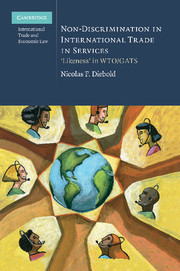Book contents
- Frontmatter
- Contents
- Foreword
- Acknowledgements
- Abbreviations
- List of Cases
- List of Legal Texts
- List of Documents
- Introduction
- PART I Foundations
- PART II Framing the conceptual breadth of ‘likeness’ in GATS
- 5 ‘Likeness’ in national treatment
- 6 ‘Likeness’ in MFN treatment
- 7 Comparative analysis of ‘likeness’
- 8 Concluding summary: economic standard
- PART III GATS specific ‘likeness’ issues
- PART IV Methodology for the ‘likeness’ analysis in GATS
- Bibliography
- Index
8 - Concluding summary: economic standard
Published online by Cambridge University Press: 10 January 2011
- Frontmatter
- Contents
- Foreword
- Acknowledgements
- Abbreviations
- List of Cases
- List of Legal Texts
- List of Documents
- Introduction
- PART I Foundations
- PART II Framing the conceptual breadth of ‘likeness’ in GATS
- 5 ‘Likeness’ in national treatment
- 6 ‘Likeness’ in MFN treatment
- 7 Comparative analysis of ‘likeness’
- 8 Concluding summary: economic standard
- PART III GATS specific ‘likeness’ issues
- PART IV Methodology for the ‘likeness’ analysis in GATS
- Bibliography
- Index
Summary
Part II of this book attempted to determine the tertium comparationis and the conceptual breadth of ‘likeness’ in Articles II and XVII GATS. It must be emphasized that this is a very abstract and theoretical exercise, which is not designed to yield a result of different and clearly defined breadths of ‘likeness’ as suggested by some commentators. Choi, for instance, proposes various standards, including ‘identical’, ‘closely similar’, ‘remotely similar’, ‘directly competitive or substitutable’ and ‘indirectly competitive or substitutable’. Such a fine classification of the ‘likeness’ concept allows consideration to be given to the particularities of the ‘likeness’ element in the various WTO provisions and thus certainly deserves merit from a doctrinal and systemic point of view. However, it is doubtful whether these classifications are in fact practically feasible, such as to demonstrate convincingly in a specific case why two products are, for instance, ‘remotely similar’ but not ‘closely similar’. Such a finding could only be validly justified if different factors underlie the various categories or if different weight is given to the same factors. Otherwise the classifications remain purely theoretical and cannot be applied to a specific set of facts. Choi excellently identifies a number of relevant factors, distinguishing between objective characteristics, demand and supply substitutability as well as potential or future competition; however, the exercise to attribute the various factors to the different classifications of ‘likeness’ proves more difficult.
- Type
- Chapter
- Information
- Non-Discrimination in International Trade in Services‘Likeness' in WTO/GATS, pp. 171 - 174Publisher: Cambridge University PressPrint publication year: 2010

